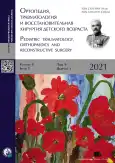Differential diagnosis of bone cysts of long tubular bones of the extremities in children
- Authors: Shpileuski I.E.1
-
Affiliations:
- Republican Scientific and Practical Center of Traumatology and Orthopedics
- Issue: Vol 9, No 1 (2021)
- Pages: 63-76
- Section: Original Study Article
- URL: https://journal-vniispk.ru/turner/article/view/16467
- DOI: https://doi.org/10.17816/PTORS16467
- ID: 16467
Cite item
Abstract
BACKGROUND: Bone cysts are characteristic tumor-like bone lesions occurring in childhood. Overall, they represent 21% to 57% of all benign tumors and tumor-like bone lesions in children. Clinical and X-ray symptoms of aneurysmal and simple bone cysts are similar. Like some other, often occurring, benign bone lesions, such as enchondromas, giant cell tumors, fibrous dysplasia, and metaphysical fibrosis defects.
AIM: This study aims to identify the main clinical and instrumental characteristics of simple and aneurysmal bone cysts that allow us to differentiate them from some similar destructive bone neoplasms (enchondromas, giant cell tumors, fibrous dysplasia, and metaphysical fibrosis defects) and to develop indications for various diagnostic surgical interventions.
MATERIALS AND METHODS: A retrospective analysis of the results of the survey of 206 patients aged 3 to 18 years who were treated at our facility from 2000 to 2015 was performed. The features of the diagnostic tactics and their effectiveness were rated.
RESULTS: The main clinical and instrumental diagnostic criteria have been established. They enable the differentiation of bone cysts from some similar benign bone lesions at the pre-morphological stage. The indications for diagnostic surgical interventions have been formulated.
CONCLUSION: The main difficulties in the differential diagnosis of bone cysts and some similar benign bone lesions have been revealed. An algorithm for applying various diagnostic surgical interventions in patients with these diseases has been proposed.
Keywords
Full Text
##article.viewOnOriginalSite##About the authors
Ihar E. Shpileuski
Republican Scientific and Practical Center of Traumatology and Orthopedics
Author for correspondence.
Email: ihar760@yandex.com
ORCID iD: 0000-0001-8098-6129
MD, PhD
Belarus, 60 building 4 Lieutenant Kizhevatov str., Minks, 220024References
- Demichev NP, Tarasov AN. Diagnostika i kriokhirurgiya kostnyh kist. Moscow: MedPress-inform; 2005. (In Russ.)
- Nejshtadt JeL, Markochev АВ. Opukholi i opukholepodobnye zabolevaniya kostej. Saint Petersburg: Foliant; 2007. (In Russ.)
- Fletcher C, Bridge J, Mertens F, editors. WHO Classification of tumours of soft tissue and bone. 4th ed. Lyon: WHO; 2013.
- Rogozhin DV, Konovalov DM, Bolshakov NA, et al. Anevrizmal’naya kostnaya kista u detej i podrostkov. Voprosy gematologii/onkologii i immunopatologii v pediatrii. 2017;(2):33–39. (In Russ.)
- Martinez V, Sissons H. Aneurysmal bone cyst. A review of 123 cases including primary lesions and those secondary to other bone pathology. Cancer. 1988;61:2291–2304.
- Santini-Araujo E, Kalil RK, Bertoni F, Park Y-K. editors. Tumors and tumor-like lesions of bone. London: Springer-Verlag; 2015.
- Lagunova IG. Opukholi skeleta. Мoscow: Medgiz; 1962. (In Russ.)
- Hakim D, Pelly T, Kulendran M, et al. Benign tumours of the bone: A review. J Bon Oncol. 2015;4:37–41.
- Starosel’tseva OA, Mnatsakanova IV, Nudnov NV. Klinicheskoe nablyudenie: Anevrizmaticheskaya kostnaya kista u rebYonka do i posle lecheniya. Meditsinskaya vizualizatsiya. 2020;1:105–112. (In Russ.)
- Adler C, Kozlowski K. Primary bone tumors and tumorous conditions in children. London: Springer-Verlag; 1993.
- Greenspan A, Jundt G, Remagen W. Differential diagnosis in orthopedic oncology. Philadelphia: Lippincott, Williams & Wilkins; 2007.
- Pope T, Bloem LH, Beltran J, et al. Musculoskeletal imaging. 2nd ed. Philadelphia: Elsevier; 2015.
- Khanna A, editor. MRI for orthopedic surgeons. New York, Stuttgart: Thieme; 2010.
- Meyers S. MRI of bone and soft tissue tumors and tumorlike lesions, differential diagnosis and atlas. New York: Thieme; 2008.
- Picci P, Manfrini M, Fabbri N, et al., editors. Atlas of musculoskeletal tumors and tumorlike lesions. The Rizzoli Case Archive; 2014.
Supplementary files












